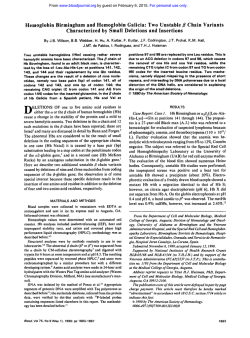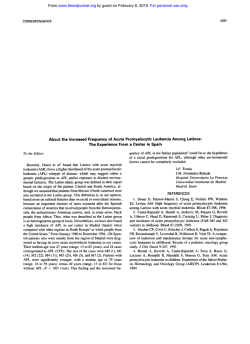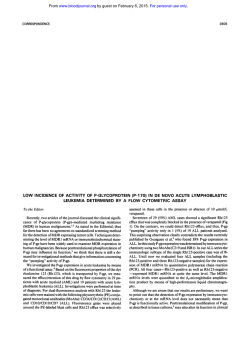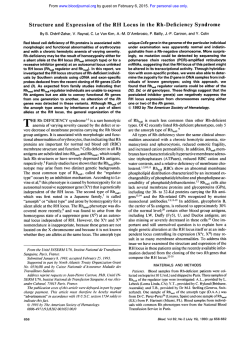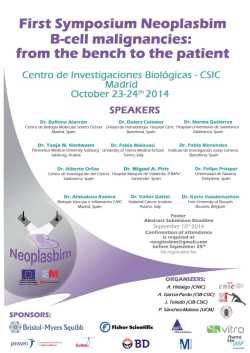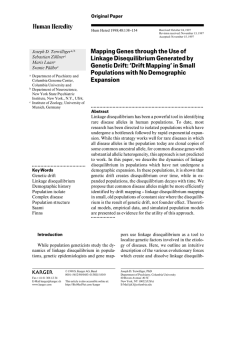
Unusual Deletions Within the Immunoglobulin Heavy-Chain
From www.bloodjournal.org by guest on February 6, 2015. For personal use only. Unusual Deletions Within the Immunoglobulin Heavy-Chain Locus in Acute Leukemias By M.J.S. Dyer, J.M. Heward, V.J. Zani, V. Buccheri, and D. Catovsky We have investigated the structure of the l g heavy (IGH) chain locus in 309 cases of acute leukemia. Seventy-one cases of B-cell precursor (BCP) acute lymphoblastic leukemia (ALL) were analyzed: in six cases deletion of joining (JH)segments in the presence of cytogenetically normal chromosome 14 was observed. Similar deletions were seen in 1 out of 8 cases of biphenotypic acute leukemia analyzed: this case exhibited t(9;22)(q34; q l 1) and coexpressed both myeloid and B cell differentiation antigens. Five of the 7 cases analyzed had deleted the J, segments from both chromosomes. Because these deletions may have contributed t o the pathogenesis of the disease w e have attempted to define their boundaries. Using probes that map both 5 and 3 of JH,the 3 (centromeric) boundary of the deletions was mapped t o an approximately 30-kb central region of the 6 0 kb between C6 and Cy3 in 10 of the 12 deleted chromosomes. In the remaining t w o chromosomes, the 3 boundary mapped to Sp. The 5 (telomeric) boundary could not be defined. However, three cases with biallelic deletion of J, showed biallelic deletion of the most proximal variable (V,) (VH6and VH5-B2) genes, indicating that the deletions spanned over 500 kb. VH5-B1 and VH5B3 were retained in germline configuration and no gross deletions were observed using a vH3 subgroup-specific probe, indicating that the 5' boundary mapped within the V, locus. Unusual deletions of the portion of the IgH locus including JH segments and the Cp and C6 genes may occur in acute leukemias with immunophenotypic evidence of commitment to the B cell differentiation pathway. The possible consequences of the deletions remain t o be determined. However, the clustering of the centromeric boundary of the deletions to Sw and t o a region between the C6-Cy3 genes, a known "hot spot" for recombination, may indicate the operation of a distinct pathogenic mechanism. 0 1993 by The American Society of Hematology. T informed patient consent. Mononuclear cell fractions were prepared by centrifugation over Ficoll-Hypaque( 1.077 g/cm3) (Sigma, St Louis, MO). Cells were washed three times in ice-cold phosphatebuffered saline (PBS) before further processing. Unfractionated PB from normal donors was used as a source of control DNA. HE GENES encoding the receptors for antigen (Ig in B cells and T-cell receptors [TCR] in T cells), are assembled during lymphocyte differentiation from widely dispersed DNA sequences, by somatic recombination.' The human Ig heavy (IGH) chain locus maps to chromosome 14q32.3 and consists of variable (V,), diversity (D,), joining (JH), and constant (C,) region geneszs3Formation of a functional IGH gene results initially from apposition of VH, DH, and JH segment^.^ The VH-DH-JH unit may be subsequently transposed to any of the further downstream, (centromeric) C, genes through homologous recombination of the switch regions, situated immediately 5' of the C, genes. The C, genes located between recombined switch regions are deleted. This process is referred to as class-switching5 Errors during the processes of creation of a VDJ unit and in class-switching may be of central importance in the pathogenesis of some 9-cell malignancies resulting in chromosomal translocations and deregulation of genes that control cell proliferation and differentiati~n.~.' As part of our diagnostic assessment of acute leukemias, we have investigated the configuration of the IGH locus using JH and C p probes in 309 cases.'-'' We and others"~'* have noted that some cases of B-cell precursor acute lymphoblastic leukemia (BCP-ALL) and biphenotypic acute leukemias with immunophenotypic evidence for commitment to the B-cell differentiation pathway may have deletions of the JH segments of either one or both chromosomes. In cases in which adequate cytogenetic data were available it was apparent that these deletions could not be caused by simple chromosomal loss, because all cases had cytogenetically normal chromosome 14s. Therefore, we have sought to define the extent and the consequences of these deletions within 14q32.3 in acute leukemias. We report the preliminary data on the mapping of the extent of the deletions. MATERIALS AND METHODS Patient Material Peripheral blood (PB) and bone marrow (BM) samples were obtained at diagnosis and in three cases at remission after obtaining Blood, VOI 82,NO 3 (August 1). 1993:pp 865-871 Immunophenotyping Immunophenotyping was performed using a panel of monoclonal antibodies (MoAbs) to T-cell, B-cell, myeloid and non-lineagespecific differentiation antigens as previously described.*-"Analysis was performedby flow cytometry and by immunocytochemistry to detect both cell-surface and cytoplasmic-antigenexpression. In certain cases, immunoelectronmicroscopy was used to detect myeloperoxidase expression." Genotypic Analysis High-molecular-weight DNA was prepared from mononuclear cells by conventional methods and digested to completion with restriction endonucleasesfor 2 hours at 37°C. Restriction endonucleases used in all samples were EcoRI, HindIII, and BamHI. Other restriction enzymes used in this study included BglII, SacI, PstI, and KpnI. DNA fragments were electrophoresed in 0.6%to 0.8% agarose and were transferred to positively-charged nylon membranes (Hybond N+; Amersham, UK) in 1.5 mol/L NaCI, 0.25 From the Academic Department of Haematology and Cytogenetics, Institute of Cancer Research-Royal Marsden Hospital, Haddow Laboratories, Sutton, Surrey, UK. Submitted October 22, 1992;accepted March 15, 1993. Supported by grantsfrom the Leukaemia Research Fund ofGreat Britain and the Kay Kendall Trust. Address reprint requests to M.J.S. Dyer, MD, DPhil, Academic Department of Haematology and Cytogenetics, Institute of Cancer Research-Royal Marsden Hospital, Haddow Laboratories, Sutton, Surrey, S M 2 SNG, UK. The publication COSIS of this article were defayed in part by page charge payment. This article must therefore be hereby marked "advertisement" in accordance with 18 U.S.C. section 1734 solely to indicate this fact. 0 I993 by The American Society of Hematology. 0006-4971/93/8203-0005$3.00/0 865 From www.bloodjournal.org by guest on February 6, 2015. For personal use only. DYER ET AL 866 mol/L NaOH by overnight capillary transfer. Hybridizationto 32Plabeled probes was performed in 0.5 mol/L sodium phosphate, pH 7.2,10% (wt/vol) sodium dodecyl sulfate (SDS), IO mol/L EDTA in a hybridization incubator (Techne, Duxford, UK), and washed to a final stringency of 0.1 X SSC (SSC is 0.15 mol/L NaCl and 0.0 I 5 mol/L sodium citrate) at 65°C for 10 minutes.14 Autoradiography was performed with intensifying screens at -80°C for 16 to 72 hours. Reprobing of filters was performed after stripping filters of radioactive probe by 60-second exposure to 1.5 mol/L NaCl, 0.5 mol/L NaOH, and washing in distilled water. To determine whether deletions involved one or both alleles, filters were hybridized simultaneouslywith a probe within the IGH locus and with D14S20, an anonymous polymorphic DNA probe that maps to the telomere of chromosome 14,telomeric of the IGH locus.’’ The total number of counts in each radioactive band was calculated by placing the labeled filter in a y-particle wire-detection system (“Autograph”; Oxford Positron, UK). The ratio of counts (IGH/D14S20) in the test samples was then compared with the ratio observed in DNA extracted from the PB of a normal individual. The majority of probes used in this study are shown in Fig 1. The derivation and full description of the genomic DNA probes used in this study may be found in the following references: ( I ) DQ52/5’JH clone, a BumHI-PstI 2.1-kb fragment.I6 (2) JH clone (C76R51A) spanning JH3 to the distal HindIII site.17 (3) Cp exons I to 3 (C57R4), a 1.2-kb EcoRI fragment.18 (4) 5%6 (pCW35), a 2.0-kb PstI fragment.” ( 5 ) YC6 (pMBW I), a I . I-kb BumHI fragment.”(6) 3’C6 (phage clone 706. I), a 17.6-kb Hind111 fragment cloned into Charon 35.19 This clone contains approximately 11 kb of DNA from the intervening sequences between C6 and Cy,. (7) Cy3 (pSy3h), a 0.6-kb Sac1 fragment derived from the four hinge regions of Cy, that shows only a small amount of cross-hybridization with other Cy genes.” (8) Probe A is a 7.6-kb BamHI fragment situated 5’ of Cy, subcloned into pBluescript from cos Ig6.21A BumHI-HindIIIfragment (probe B) correspondingto the Iy, region has also been derived from this cosmid.22Other probes used in this study not shown in Fig 1 included (9) A V“6-specific probe, the VH6gene maps approximately90 kb telomeric of JH.23 (10) A VH5subgroup-specific probe. Three VH5genes have been identified that lie approximately 400, 900, and 1100 kb telomeric of JH.24These correspond to 16.0-, 10.3-, and 5.6-kb fragments seen in HindIII digests on conventional DNA bl~tting.~’ Both probes were kindly provided by P.W. Tucker (Dallas, TX). (1 1) A VH4-subgroupspecific probe derived from a genomic B-cell chronic lymphocyticleukemia (B-CLL) DNA library (M.J.S.D. and V.J.Z., unpublished observations, 1992) In an attempt to exclude cytogeneticallycryptic MYC translocations involving the IGH locus, rearrangements were sought using an MYC cDNA probe in Hind111 and BamHl restriction digests? no rearrangements were detected. All probes were used as gel-purified inserts and were labeled with 32P-dCTPto specific activity of 2 2 X IO9 disintegrations per minutelpg DNA by the method of ~ligo-priming.~~ When using the 706.1 probe and probe A, hybridization of repetitive DNA sequences was inhibited by prehybridization of the labeled probe to Cot-I DNA (GIBCO-BRL, Gaithersburg, MD), according to the manufacturer’s instructions. RESULTS Frequency of JH Deletions in Acute Leukemias As part of our routine diagnostic assessment we have analyzed the configuration of the IGH locus in 309 cases of Kb from JH 0 t 5 10 I I 1 I JH1-6 / H m l m2 1 1 1 I I E I H C76R51A 6r I E CAM Jo CH3 C6 CH 1 4 11 1 1 1 1 DQ52 25 I I cv SP Dag + 20 15 N CHI h2 CH2 I 1 II I E hl Ill I BBI I B I 1 I I I B HH P - Kb approx from JH 7o m A mlmZ CH1 h 1 4 CH2-3 111 II 11B pMBW1 B 706.1 I B I l l E H E I E II BH B probe A H - PSslJh probe B Fig 1. Schema of the 5 region of the human IGH locus showing the relative positions of the DNA probes used in this study. The distance in kilobases from the 5 end of the JH region is shown. Note that in man the region between C6 and Cy3 has not yet been cloned but has been estimated from pulsed-field data to be about 60 kb in length.23“E” denotes €coRI, ”H” Hindlll, and “B” 6amHl sites. From www.bloodjournal.org by guest on February 6, 2015. For personal use only. 867 IMMUNOGLOBULIN DELETIONS IN ACUTE LEUKEMIA Characteristicsof Patients With JH Deletions acute leukemia.'-'' Diagnosis was made on cytologic and cytochemical appearances, supplemented by detailed imPatient characteristics are summarized in Table 1. The munophenotypic analysis of both cell surface and cytoplasfollowing features are of note. Firstly, J, deletions were obmic antigen expression as previously d e ~ c r i b e d . ' ~ Bi* ~ ~ ~ ~served * both in pediatric and adult cases. All patients atphenotypic leukemias were defined by the concurrent tained complete remission. Although all the adult patients expression of multiple antigens of more than one hematosubsequently relapsed and died, both pediatric patients (papoietic lineage on individual blasts: a weighted scoring systients 2 and 6 in Table l) remain in remission 30 and 20 tem was used to differentiate reproducibly possible biphenmonths after diagnosis, respectively. Therefore, it is unotypic cases from leukemias which expressed "unexpected" likely that JH deletions are associated with a specific progdifferentiation antigens, such as CD7+acute myeloid leukenostic subgroup. This is reflected in the cytogenetic divermia (AML) and ALL that expressed single myeloid antisity observed in these cases. All cases retained two copies of gens.28 cytogenetically normal chromosome 14. The case of biUsing these criteria, the cases analysed comprised 210 phenotypic acute leukemia had the t(9;22)(q34;q 1 1) transcases of AML, 7 1 cases of BCP-ALL, and 20 cases of T-cell location with rearrangement of the BCR gene detected on precursor ALL (TCP-ALL): eight cases were considered to conventional DNA blot; however, there was no docube biphenotypic acute leukemia. mented antecedent chronic myeloid leukemia (CML)." Of the 71 cases of BCP-ALL, 8 exhibited obvious deleTrisomy 21 was seen in three cases: in one case this was tions of one or both J, segments. Four cases had deleted associated with Down's syndrome. In our series of 7 1 cases both alleles of JH (Table 1: cases 1 through 4), whereas 4 had of BCP-ALL of 30 cases examined, 10 had rearrangement deleted a single JH allele: of this latter group in only 2 cases and/or deletion of CKgenes whereas five had rearrangement were cytogenetic data available and therefore only 2 ofthese of CX genes.'' However, 6 of 7 cases with JH deletions had 4 were studied in further detail (Table 1: cases 6 and 7). rearrangement and/or deletion of the Ig light-chain genes. One of the 8 biphenotypic leukemias studied exhibited The somatic origin of these deletions was shown by the biallelic deletion of ,J (Table 1: case 5). This case, which presence of normal-sized JH fragments in DNA from remishad the cytologicappearances of an undifferentiated, Sudan sion BM samples in cases 1, 2, and 7. Also, in case 1 it was Black-positive AML, and coexpressed abundant myeloid possible to derive phenotypically normal polyclonal B-cells antigens (CDl3, CD33, and myeloperoxidase), was considby Epstein-Barr viral transformation of a remission sample ered biphenotypic by the simultaneous expression of both (data not shown). CDlO and CD19 indicative of commitment to both myeloid and B cell differentiation pathways." Otherwise neiMapping the Extent of the Deletions Within the IGH Locus ther monoallelic nor biallelic JH deletions were observed in any of the cases of AML or TCP-ALL studied. The extent of the deletions within the IGH locus on Because these deletions may have contributed to the 14q32.3was mapped using the probes shown in Fig 1. Reppathogenesis of the disease, we therefore attempted to map resentative conventional Southern DNA blots are shown in their extent within the IGH locus in the seven cases in which Figs 2 and 3. cytogenetic data indicated the presence of cytogenetically Dejnition of the 3'(centromeric) boundary. Of the 7 cases examined, 10 of the 14 IGH loci showed deletion of intact chromosome 14. Table 1. Summary of Data on Patients With Deletions Within the IgH Locus 5 IgH Locus Case/ Material Age/ Sex 1 PB/BM 2 PBlBM 3 BM 4 PB 5 PB 5 BM 6 PB 7 PB 1JIM 13/F 42/M 35/M 46/F 46/F JF 3JIM WCC Cytogenetics 155 75 2.5 259 Trisomy 2 1 Hyperdiploid Hyperdiploid Trisomy 21 t(9;22)(q34;qll) t(9;22)(q34;q11) t(7;9)(~15;q13) 46,XY 87 87 35 16 0 IgL Locus 706.1 lgCK lgCh DID G/R G/R G/R NIT R/R DID GIG G/R GIG GIG NIT NIT GIG G/R GIG All cases with the exception of case 5 had the immunophenotypeof BCP-ALL, ie, CD19+CD1O+TdT+ clgp-. Case 5 coexpressed both myeloid and B cell differentiation antigens as well as t(9;22)(q34;qll) and was therefore classifiedas a biphenotypic acute leukemia.'0,28PB and/or BM samples were studied as indicated: identical results were obtained from both sources in cases 1 and 2 but in case 5 a clear rearranged Cp fragment was observed in BM but not in the corresponding blood sample. Remission samples from patients 1, 2, and 6 showed normal configuration of JHand Ca sequences. Trisomy 21 was associated with Down's syndrome in case 1 but not case 4: trisomy 21 was also a component of the hyperdiploidy seen in case 2. Abbreviations: WCC, white blood cell count; D, deleted; G,germline; R, rearranged DNA fragments; NT, not tested; r and g in case 6 denote that only faint rearranged and germline were observed in this case, suggesting that the majority of cells might in fact have undergone biallelic J,ICaIC8 deletion (see Fig. 2). From www.bloodjournal.org by guest on February 6, 2015. For personal use only. DYER ET AL 868 A B BCP-ALL BCP-ALL *N 4 C *- * N 4 D BCP-ALL BCP-ALL N -N ~ 23.1 Kb > ’- a- > I 16 j I -. 9.4 6.6 > > > > Probe 1 3 JH 6 -ma- -1 35 1)4 i ! I i II ‘ *L Case No: > 1 I > 1 N 1 CP CY3 3 6 N MYC Fig 2. JH deletions in BCP-ALL representativeSouthem blot showing 68mHI-digested D N A s from BCP-ALL‘S (cases 1,3, and 6, Table 1) and DNAf” unfractionated PBfrom a normal individual(denoted by ”N”) probed successively with (A) JHprobe C76R51A. (6)Cw probe C75R4, (C) Cy3 probe pSr3h. (D) MYC cDNA probe cDIA. Note no detectableJHor Cpfragments in cases 1 and 3 and only faint band in case 6 (arrowed). (C) shows retention of Cy3 in cases 1,3, and 6 whereas (D)shows that the variation in the intensity of the signal with the Cy3 probe reflects variation in the amount of DNA loaded per lane. Fragment sizes were determined by coelectrophoresis of ’phage A cut with Hindlll. Germline fragments and fragment sizes are denoted by horizontal bars to the right of each panel. Rearranged J, and Cp fragments are shown by arrows. both JH and Cp. However, two loci (cases 1 and 5 , Table 1) retained Cp in a rearranged configuration. These rearrangements were detected in both HindIII and XbaI restriction digests, indicating that rearrangement to Sp had occurred. The biphenotypic leukemia had different configuration of Cp in PB and BM samples. In the BM sample, a clear rearranged Cp fragment was observed, whereas the same fragment was not detected in the PB. The reasons for this difference are obscure but may reflect continuing rearrangement. Variation in the configuration of the IGH locus between blood and BM samples has been reported previously.29 All cases with deletion of Cp exhibited deletion of all C6 sequences. No rearrangement of three probes that map to C6 and its immediate 3‘ region was observed in any case. Therefore, the configuration of the closest 3’ (centromeric) CH gene was examined using a probe specific for CY^.^' From pulsed-field data it has been estimated that Cy3 maps about 60 kb 3’ of C623(Fig I). No rearrangements of Cy3 were detected in any of the cases with a wide range of enzyme digests. Using simultaneous hybridization with the Cy, and a probe outside the IGH locus, quantitative imaging showed that both alleles of Cy, were retained (Fig 3). Therefore, all deletions that involved both JH and Cp mapped between C6 and Cy3. This region has not been completely cloned in man. Probes to the IT, region (the region from which transcription of Cy, initiates in the absence of class-switching22)and to a region further 5’ were derived from a previously isolated cosmid clone, c0sIg6.~’ Again both probes retained germline configuration in a variety of enzyme digests. Isolation of further informative 5’ probes has been hampered by the presence of highly repetitive DNA. Therefore, these data indicate that in all cases studied the Yboundary of the deletions mapped to the central and thus far uncloned region of about 30 kb of the 60-kb region between C6 and Cy3 or more rarely to Sp. Dejnition ofthe 5’ (telomeric) boundary. All five cases with biallelic deletion of JHshowed biallelic deletion of both the 5’ region of JH and the most proximal DH region DQ52.I6 A variety of probes were used in an attempt to determine the telomeric boundary. Firstly, a probe outside the JH locus that has been mapped close to the telomere of chromosome 14 within the 14q32.3 band (D14S20”) was used: both copies of this were retained in all cases (Fig 3). The V, region was then investigated using probes specific for vH3, 4, 5 , and 6 gene subgroups: these sequences are dispersed over at least 2,500 kb on chromosome 14q32.3.24 The VH6gene is located 90 kb distal of JH and is the single member of the subgroup: all five cases with biallelic JHdeletion showed biallelic deletion of vH6. The vH5 subgroup contains three members, VH5-B1,B2, and B3 that map a p proximately 1100, 400, and 900 kb telomeric of JH: these genes correspond to bands of 5.6, 16.0, and 10.3 kb, respectively in HindIII digests on Southern blot analy~is.2~ Three cases (cases I , 2, and 4, Table 1) with biallelic JH deletion showed loss of the 16-kb HindIII band but retention of the lower two bands. Similarly, probing with a vH3 subgroup From www.bloodjournal.org by guest on February 6, 2015. For personal use only. IMMUNOGLOBULIN DELETIONS IN ACUTE LEUKEMIA 869 probes B) le73 and D14S20 A) 1 2 3 1 2 3 23.1 > -CP 9.4 > 6.6 > 4.4 > Fig 3. Biallelic deletions of JHwith biallelic retention of Cy3 and D14S20. DNA from: track 1, a case of TCP-ALL: track 2, biphenotypic acute leukemia with biallelic JH/Cr/C6deletion (case 5, Table l); track 3,unfractionated PB from a normal individual. DNA's were digested with Bg/ll and probed successively with (A) Cr probe and (B) D14S20 and C?3 probes simultaneously. The filter labeled with both D14S20 and Cy3 probes was placed in an "Autograph" y-particle wire detector and counted. Histograms from the areas of interest containing both bands seen on the autoradiograph are shown in (C). These show the same ratio of counts in both Cy3 and D14S20 bands in all three cases indicating biallelic retention of CY,. specific probe, V, 26.8. showed no gross deletions of this region (data not shown). Therefore, these data indicate that the telomeric boundary of the deletions in cases with biallelic JHdeletions resides within the V, locus, between VH5-B2 and VH5-B3, ie, between 400 and 900 kb distant from J H . DISCUSSION We have shown that a subgroup BCP-ALL (6 of 7 1 cases analyzed in this study) and some cases of biphenotypic acute leukemia with cytogenetically normal chromosome 14 may have deleted a crucial segment of the IGH locus at I4q32.3. In about half the cases, the deletions involved both alleles. Similar results have been reported recently by Beishuizen et al." From our survey ofacute and chronic leukemias it appears that such deletions occur only in acute leukemias of precursor cells that have made some commitment to the B-cell lineage; similar deletions in the absence of structural cytogenetic abnormalities of chromosome 14 were not observed in TCP-ALL, AML, or in a range ofchronic leukemias of mature B-cellss-'o (and M.J.S. Dyer, H.Kayano, D. Jadayel, unpublished observations, 1993). The restricted distribution and the clustering of deletion breakpoints to either Sp or to the central 30-kb region between Cb and Cys suggest that the deletions arose as a consequence of a specific mechanism operating on a subset of B-cell precursors. From www.bloodjournal.org by guest on February 6, 2015. For personal use only. DYER ET AL The precise extent, nature, and any possible biologic significance of such deletions await molecular cloning experiments. These experiments have so far been hampered by the lack of probes spanning the area between C6 and Cy3and by the highly repetitive nature of the DNA in this region. The corresponding region in the mouse (which is also 60-kb long) has been cloned in bacteriophage? neither coding nor switch regions were identified and thus the functional significance, if any, of the region remains to be determined. Using single-copy probes derived from the mouse bacteriophage clones, we have failed to identify any homologous sequences within the human CG-Cy, region (J.M.H., M.J.S.D.; unpublished observations, 1992). Interestingly, genetic linkage analysis has shown that the region between C6 and Cys is a “hot spot” for recombination in humans.31 Unlike the B cell non-Hodgkin lymphomas, the IGH locus is not commonly a target for chromosomal translocations in BCP-ALL.32Translocations involving 14q32.3 in pediatric leukemias have been associated with mixed lineage cases and have been shown not to involve the JH sequences directly, leading to the suggestion that an unidentified gene of importance in leukemogenesis may reside on 14q32.3.33 Whether the deletions described here result in the aberrant expression of other genes within the IGH locus in the 14q32.3 chromosomal band, and whether this expression is of importance in the pathogenesis of BCP-ALL, remains to be determined. ACKNOWLEDGMENT We thank the following for kindly providing DNA probes: Prof P.W. Tucker (Dallas, TX), Dr T.H. Rabbitts (Laboratory ofMolecular Biology, Cambridge, UK), Prof M.P. Lefranc (Montpellier, France), Dr T. Honjo (Kyoto, Japan), and Dr T. Ford (Institute of Cancer Research, London, UK). We thank the Japanese Shipbuilding Institute for kindly providing the mouse CG-Cy, bacteriophage clones, and Dr Val Broadbent, Department of Paediatrics, Addenbrooke’s Hospital, Cambridge, UK for permission to report case 2. REFERENCES I . Berg D, Howe M: Mobile DNA. Washington, DC,American Society of Microbiology, 1989 2. Kirsch IR, Morton CC, Nakahara K, Leder P: Human immunoglobulin heavy chain genes map to a region of translocations in malignant B lymphocytes. Science 2 16:301, 1982 3. Alt FW, Blackwell TK, Yancopoulous GD: Development of the primary antibody repertoire. Science 238: 1079, 1987 4. Lieber MR: Site-specific recombination in the immune system. FASEB J 5:2934, 1991 5. Esser C, Radbruch A: Immunoglobulin class switching: Molecular and cellular analysis. Annu Rev Immunol 8:717, 1990 6. Tycko B, Sklar J: Chromosomal translocation in lymphoid neoplasia: A reappraisal of the recombinase model. Cancer Cells 2:1, 1990 7. Rabbitts TH: Translocations, master genes, and the differences in the origins of acute and chronic leukemias. Cell 67:641, 1991 8. Dyer MJS: T-cell receptor 6/01 rearrangements in lymphoid neoplasms. Blood 74: 1073, 1989, 9. Dyer MJS, Hoyle CF, Rees JKH, Marcus RE: T-cell receptor and immunoglobulin gene rearrangements in acute myeloid and undifferentiated leukemias of adults: Correlation with weak surface expression of CD45 and CDw52 antigens. Leuk Lymph 3:257, 1991 10. Buccheri V, Matutes E, Dyer MJS, Catovsky D Lineage commitment in biphenotypic acute leukemias. Leukemia I993 (In press) 11, Beishuizen A, Hahlen K, Hagemeijer A, Verhoeven MAJ, Hooijkaas H, Adriaansen HJ, Wolvers-Tettero ILM, van Wering ER, van Dongen JJM: Multiple rearranged immunoglobulin genes in childhood acute lymphoblastic leukemia of precursor B-cell origin. Leukemia 5:657, 1991 12. Lim SH, OConnor S, Bloxham D, Lynn R, Broadbent V, Dyer MJS, Marcus RE: CD2+, CD 19’ biphenotypic acute lymphoblastic leukemia: A report of three cases and review of the literature. Leuk Lymph 6:167, 1992 13. Bucchen V, Shetty V, Yoshida N, Morilla R, Matutes E, Catovsky D: The role of an anti-myeloperoxidase antibody in the diagnosis and classification of acute leukaemia: A comparison with light and electron microscopy cytochemistry. Br J Haematol80:62, 1992 14. Dyer MJS: An advanced hybridisation incubation oven for the routine laboratory. Lab Practice 40:45, 199 I 15. Nakamura Y, Lathrop M, OConnell P, Leppert M, Kamboh MI, Lalouel JM, White R Frequent recombination is observed in the distal end of the long arm of chromosome 14. Genomics 4:76, 1989 16. Mizutani S, Ford AM, Wiedemann LM, Chan LC, Furley AJW, Greaves MF, Molgaard HV: Rearrangement of immunoglobulin heavy chain genes in human T leukemic cells shows preferential utilization of the D segment (DQ52) nearest to the J region. EMBO J 5:3467, 1986 17. Ranagan JG, Rabbitts TH: The sequence ofa human immunoglobulin epsilon heavy chain constant region gene and evidence for three non-allelic genes. EMBO J 1:655, 1982 18. Rabbitts TH, Forster A, Milstein CP: Human immunoglobulin heavy chain genes: Evolutionary comparisons of C mu, C delta and C gamma genes and associated switch sequences. Nucleic Acid Res 9:4509, 1981 19. White MG, Shen AL, Word CJ, Tucker PW, Blattner F R Human immunoglobulin D Genomic sequence of the delta heavy chain. Science 238:733, 1985 20. Huck S, Keyeux G, Ghanem N, Lefranc M-P, Lefranc G: A gamma 3 hinge region probe: First specific human immunoglobulin subclass probe. FEBS Lett 208:221, 1986 2 I. Flanagan JG, Rabbitts TH: Arrangement of human immunoglobulin heavy chain constant region implies evolutionary duplication of a segment containing y. c and 01 genes. Nature 300:709, 1982 22. Sideras P, Mizuta T-R, Kanamori H, Suzuki N, Okamoto M, Kuze K, Ohno H, Doi S, Fukuhara S, Hassan MS, Hammerstrom L, Smith E, Shimizu A, Honjo T Production of sterile transcripts of Cy genes in an IgM-producing human neoplastic B-cell line which switches to IgG-producing cells. Int Immunol 1:63 1, 1989 23. Hoker MH, Walter MA, Cox D W Complete physical map of the human immunoglobulin heavy chain constant region gene complex. Proc Natl Acad Sci USA 865567, 1989 24. Walter MA, Surti U, Hofker MH, Cox DW: The physical organisation of the human immunoglobulin heavy chain gene complex. EMBO J 10:3303, 1990 25. Humphries CG, Shen A, Kuziel WA, Capra JD, Blattner FR, Tucker PW. A new human immunoglobulin V, family preferentially rearranged in immature B-cell tumours. Nature 33 1:446, 1988 From www.bloodjournal.org by guest on February 6, 2015. For personal use only. IMMUNOGLOBULIN DELETIONS IN ACUTE LEUKEMIA 26. Rabbitts TH, Hamlyn PH, Baer R: Altered nucleotide sequences of a translocated C-MYC gene in Burkitt lymphoma. Nature 306:760, 1983 27. Feinberg AP, Vogelstein B: A technique for radiolabeling DNA fragments to high specific activity. Anal Biochem 132:6,1983 28. Catovsky D, Matutes E, Bucchen V, Shetty V, Hanslip J, Yoshida N, Morilla R: A classification of acute leukaemia for the 1990’s. Ann Hematol62:16, 1989 29. Bieshuizen A, Verhoeven M-AJ, Hahlen K, van Wering ER, van Dongen JJM: Differences in immunoglobulin heavy chain gene rearrangementpatterns between bone marrow and blood samples in childhood precursor B-acute lymphoblastic leukemia at diagnosis. Leukemia 6:60, 1992 30. Shimizu A, Takahashi N, Yaoita Y , Honjo T: Organization 871 of the constant region gene family of the mouse immunoglobulin heavy chain. Cell 28:499, 1982 3 1. Berger JC, Teshima I, Walter MA, Brubacher MG, Darouk GH, Cox DW: Localisation and genetic linkage of the human immunoglobulin heavy chain genes and the creatinine kinase brain (CKB) gene: Identification of a hotspot for recombination. Genomics 9:614, 1991 32. Pui CH, Cnst WM, Look AT: Biology and clinical significance of cytogenetic abnormalities in childhood lymphoblasticleukemia. Blood 76:1449, 1990 33. Hayashi Y , Pui CH, Behm FG, Fuchs AH, Raimondi SC, Kitchingham GR, Mirro J, Williams D L 14q32 translocations are associated with mixed lineage expression in childhood acute leukemia. Blood 76: 150, 1990 From www.bloodjournal.org by guest on February 6, 2015. For personal use only. 1993 82: 865-871 Unusual deletions within the immunoglobulin heavy-chain locus in acute leukemias MJ Dyer, JM Heward, VJ Zani, V Buccheri and D Catovsky Updated information and services can be found at: http://www.bloodjournal.org/content/82/3/865.full.html Articles on similar topics can be found in the following Blood collections Information about reproducing this article in parts or in its entirety may be found online at: http://www.bloodjournal.org/site/misc/rights.xhtml#repub_requests Information about ordering reprints may be found online at: http://www.bloodjournal.org/site/misc/rights.xhtml#reprints Information about subscriptions and ASH membership may be found online at: http://www.bloodjournal.org/site/subscriptions/index.xhtml Blood (print ISSN 0006-4971, online ISSN 1528-0020), is published weekly by the American Society of Hematology, 2021 L St, NW, Suite 900, Washington DC 20036. Copyright 2011 by The American Society of Hematology; all rights reserved.
© Copyright 2026



